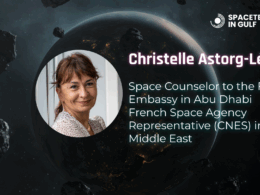
Welcome to our interview with Jakub Kapuš, the CEO of Spacemanic. Spacemanic is a pioneering force in the field of nanosatellite solutions, specializing in turnkey services and CubeSat component manufacturing. With a strong focus on plug-and-play methodology, the company streamlines the design, development, and testing of small satellite components, aiming to significantly reduce the time required for missions to transition from concept to orbit.
Jakub Kapuš brings a wealth of experience to the table as a co-founder of the Slovak Organisation for Space Activities (SOSA) and a driving force behind Slovakia’s collaboration with the European Space Agency (ESA). Under his leadership, SOSA played a pivotal role in facilitating Slovakia’s entry into European space programs, culminating in the successful launch of the skCUBE satellite in 2017.
Currently, Jakub is dedicated to fostering international cooperation and projects at SOSA, alongside his mission to establish space spin-off companies in Slovakia. Additionally, he founded Spacemanic, s.r.o., to further advance nanosatellite technologies and make space more accessible to a diverse range of customers. Jakub’s expertise and vision continue to shape the landscape of the space industry, as he represents Slovakia in key ESA and COPUOS committees.
In this interview, we delve into Jakub’s insights, experiences, and the future of Spacemanic in the rapidly evolving space sector. Join us as we explore the journey of Spacemanic and the visionary leadership of Jakub Kapuš.
Can you provide an overview of Spacemanic’s mission and the key objectives the company aims to achieve in the nanosatellite industry?
Spacemanic is a turnkey nanosatellite mission provider, and a manufacturer of components for CubeSats, small satellites, and launch vehicles. The company is dedicated to create and launch satellites in a seamless way, with an average lead time of (less than) six months from handshake to orbit. Plug-and-play methodology allows us to make access to space easy, quick, and affordable. With a proprietary line of sub-systems, we also aim to lower the costs of launching customer payloads; making space more reachable to a broad range of industries, institutions, and academia. Spacemanic aspires to launch satellites not only to LEO but also much further with the next stop being the Moon.


How does Spacemanic differentiate itself from other players in the nanosatellite solutions market, and what unique value does the company bring to its customers?
Our plug-and-play solutions, robust architecture, and modularity of the whole platform allows for straightforward integration and therefore cut the time from idea on a drawing board to an actual satellite flying and reliably working in space. Shorter lead times, client-oriented approach, and extensive flight heritage are the main ingredients. The secret spice is the relentless team of professionals committed to support our customers every step of their journey. All of that with a reasonable price- point, tailored to fit the needs of each mission.
In what ways does Spacemanic leverage the plug-and-play methodology in the design and development of fundamental small satellite components?
The logic behind our designs allows us to streamline the design and development of our components, and enables faster and more efficient integration of all our subsystems. Getting rid of unnecessary headache with intercompatibility, extensive customization, and non-standard approaches. This results in shorter development time and costs, and allows our company to have faster turnaround for satellite missions.
Can you share specific examples of successful nanosatellite missions facilitated by Spacemanic, highlighting the impact and achievements?
A prime example of a successful mission is the GRBAlpha CubeSat, dedicated to detecting gamma bursts from deep space. Still active in orbit for over thousand days, it has detected several notable gamma bursts which earned it official recognition by NASA, relevant space media and, proved that even small, low-budget satellites are capable of gathering valuable scientific data on a regular basis. We are looking forward to its successor, GRBBeta, being launched in the near future. Hopefully, it shall bring even more breakthrough discoveries for the astrophysics team.
With a focus on accessibility, how does Spacemanic tailor its solutions to meet the needs of diverse clients, including scientific institutions, universities, and private entities with varying budget sizes?
With satellite missions, it is always about finding the delicate balance without compromising the quality, and reliability of our work. On one side there are customer requirements, on the other side there are the real technical possibilities within allocated budget, and within specific timeframe restrictions, also previous knowledge and experience of the client (or lack of it). Our modular design allows for easy customization and integration, ensuring clients can select components aligning with their mission objectives, and financial constraints. We offer comprehensive support to varying expertise levels, making space exploration accessible to a wide range of clients. By maintaining transparency in pricing, and providing scalable solutions, Spacemanic aims to facilitate affordable and inclusive space missions for all.
What are some of the key challenges and opportunities you foresee for Spacemanic in the evolving landscape of the nanosatellite industry?
Key challenges for Spacemanic include regulatory compliance and evolving technology standards. Opportunities lie in expanding applications for nanosatellites and addressing emerging market needs, and mostly in the humanity returning to the Moon. Lunar missions are the future.

How does Spacemanic approach innovation within the company, and what steps are taken to stay at the forefront of technological advancements in the space sector?
Spacemanic promotes innovation through a culture of creativity and mutual inspiration. We are actively engaging with industry experts, academic institutions, and research partners to stay informed about emerging trends. Talent acquisition is a priority, ensuring a diverse team of colleagues. Spacemanic also participates in industry events for knowledge exchange. This agile approach allows us to swiftly adopt and integrate the latest technological advancements.
How does Spacemanic foster collaboration with other entities in the space industry, including partnerships or collaborations with research institutions, space agencies, or private companies?
Collaboration is an integral part of the „Spacemanic philosophy “. We engage in partnerships and alliances with all the industry players to leverage collective expertise and contribute to advancements in the field of the space industry regionally, but also globally. Spacemanic seeks to establish synergies that drive innovation and address shared challenges. Having industry partners also allow for offering wholesome solutions on the market, that will provide everything a customer might need, aside from the satellite platform itself. Data processing, and comprehensive ground services come to mind as great examples of such possible partnerships.

Can you share insights into the future roadmap for Spacemanic, including any upcoming projects, expansions, or advancements in technology?
Spacemanic is currently laser-focused on bringing the CORVUS – advanced nanosatellite platform, to the market. The project, which is a part of ESA’s Pioneer program, will offer a cutting-edge technology for a broad spectrum of customers, addressing ever-evolving market demands and challenges, especially in the field of rapid response, and Earth observation.
How does Spacemanic contribute to the broader goals of space exploration and technology advancement, and what impact do you foresee the company having on the industry in the coming years?
With our vision of making space accessible to diverse range of clients, Spacemanic is dedicated to providing reliable and affordable solutions. In the spirit of true democratization of space, we are always happy to support scientific, and educational projects. We are committed to align our efforts with ESA’s key objectives, especially sustainability and clean space. Through these initiatives, Spacemanic envisions not only contributing to a more inclusive and sustainable space industry but also participating in a transformative era characterized by accessibility, innovation, and a commitment to environmental well-being.

Alex Cresniov, Founder of SpaceTech in Gulf
About the author: Passionate in the Space industry with significant expertise in Policy Making, Global Socio-Economic Assessments, and DeepTech Analytics.
Email: alexei@spacetech-gulf.com









